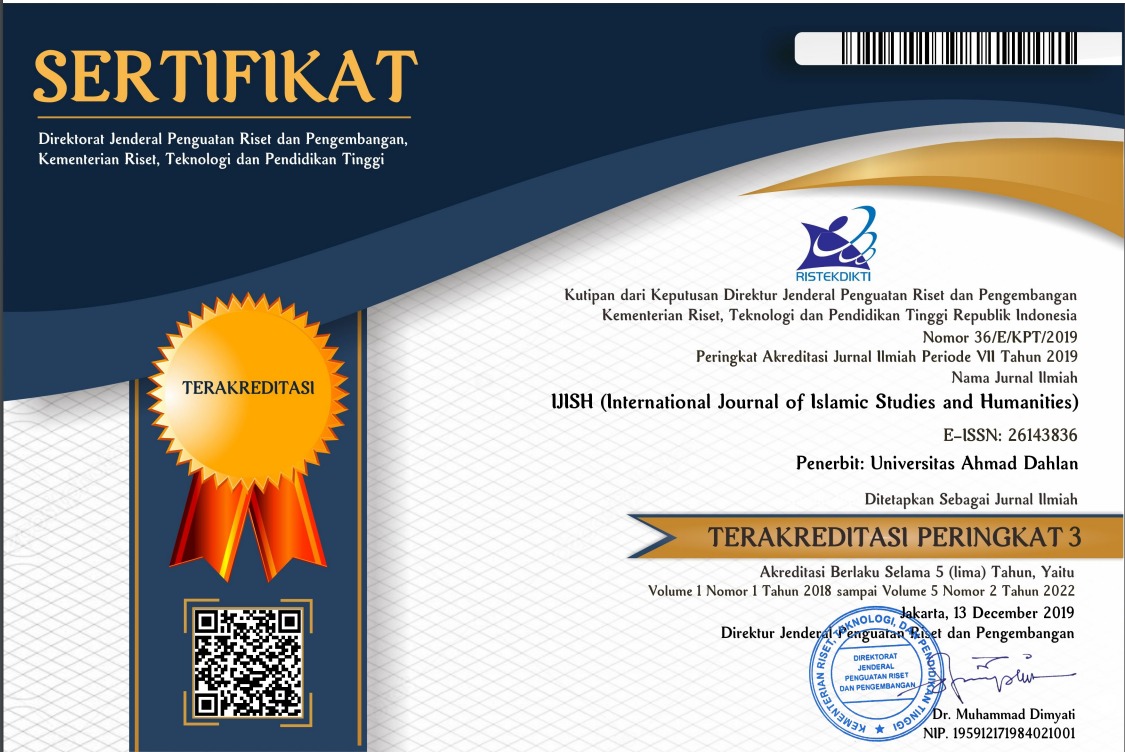فهم النص القرآني بالطريقة السيميائية قصة صاحب الجنتين نموذجا
DOI:
https://doi.org/10.26555/ijish.v3i1.2025Keywords:
النص القرأن, السيميائية, العلامات, الأيقونيةAbstract
إن فهم القرأن مازال منفتحاً و فيه ميدان اجتهادي لتحقيق قيم القرأن في الحياة لأن تعاليم الإسلام الشاملة لا توعي في لغة ثقافيّة و هي اللغة العربيّة. و فهم القرأن الذى يركز وجها فائقا يتولّد فهما أفقيا و هو بين المؤلّف (الله) و بين النّصوص (القرآن)، و أمّا جهة القارئ الذى كان هو من تاريخيّة القرأن فيفقد و لذلك صار القرأن نصا الهيا و ليس هو نص بشري. ولو كان القرأن هو الوحي لكن هو نصوص لغويّة بشريّة لأنّه يدون و يكتب في لغة ثقافيّة و هي اللغة العربيّة الّتى نزل في وقت وظروف معيّنة. وهذا البحث هو فهم النص القرآن بالطريقة السيميائية بأخذ قصة صاحب الجنتين نموذجا. ويقوم هذا البحث بتقييم دور هام الطريقة السيميائية لفهم معاني القرآن الكريم. وكان القرأن ذاتي فعالي يبلغ الوصايا الخلقية لدى القارئ الذي يعيش فى زمن مختلف. و النصوص القرأنيّة ليست محدودة على النصوص المقروءة والمكتوبة ولكن هذا العلم يسمّى أيضاً نصوصا (الدّال) اذا بحثه وجد المعانى الذى لايحضر (المدلول). ونتجة البحث تدل على أن السيميائية كان له دور هام لفهم معانى القرآن لأنه علم يبحث عن العلامة و العلامة ليست محدودة على اللغة بل كانت مظاهر المجتمع وثقافاته وعاداته هي علامات. كما وجدنا هذه ﺍﻟﻭﺤﺩﺍﺕ ﺍﻟﺴﻴﻤﻴﺎﺌﻴﺔ في القصة صاحب الجنتين
References
Arkoun, Muhammad, “Algeria†dalam Shireen T. Hunter (ed.), The politics of Islamic Revivalism, Bloomington: Indiana University Press, 1988
Barthes, Roland.. Elemen-Elemen Semiotika. (Terjemahan M. Ardiansyah). Jogjakarta: IRCiSoD, 2012
Chaer, Abdul, Linguistik Umum, Jakarta: Rineka Cipta, 1994
Culler, Jonathan, The Pursuit of Signs, London: Methuen & Co. Ltd, 1981
Darraz, Abdullah, an-Naba’ al-Azhìm, Mesir: Dà r al-‘Urubah, 1960
Dzahabi, Muhammad Husein, at-Tafsaìr wa al-Mufassirìn, jilid II, Mesir: Dà r al-Maktabah al-Hadìtsah, 1976
Faudah, Mahmud Basuni, Tafsir-tafsir al-Qur’an: Perkenalan dan Metodologi Tafsir, terj. Abdul Qodir Hamid, Bandung: Pustaka, 1987
Habil, Abdurrahman, Tradisional Esoteric Commentaries on The Qur’an, New York: Crossroad, 1991
Haryono, M. Yudhie R, Bahasa Politik Alqur’an, Bekasi: Gugus Press, 2002
Hidayat, komaruddin, Memahami bahasa agama,; Sebuah Kajian Hermeneutik, Jakarta: Paramadina, 1996
Khalìl, Ahmad, Dirà sat fì al-Qur’à n, Mesir: Dà r al-Ma’à rif, tt.
Luxemburg, Jan Van, dkk., Inleiding in de Literatuurwetenschap, Muiderberg, 1982, terj. Dick Hartoko, Pengantar Ilmu Sastra, Jakarta: Gramedia, 1992
Madjid, Nurcholish, Cendikiawan dan Religiusitas Masyarakat, Jakarta: Paramadina, 1999
Palmer, Ricard E., Hermeneutic, Evanston: Northwestern University Press, 1969
Poonwala, Ismail, L, Isma’ily Ta’wìl of the Qur’an, Oxford: Clarendon Press, 1988
Pradopo, Rachmat Djoko, Pengkajian Puisi, Yogyakarta: Gadjah Mada University Press, 1993
________, Beberapa Teori Sastra, Metode Kritik dan Penerapannya, Yogyakarta: Pustaka Pelajar, 1995
Quthb, Sayyid, Tashwìr al-Fann fì al-Qur’à n, Cairo: Dà r al-Ma’à rif, 1975
________, Fì Zhilal al-Qur’à n, Beirut: Dà r Ihya al-Turà ts al Arabi,1386 H./1967 M
Ricour, Paul, Interpretation Theory; Discourse and the surplus of Meaning, The Texas Christian University, 1976
Riffaterre, Michael, Semiotics of Poetry, Bloomington-London: Indiana University Press, 1978
Shahih Muslim, Beirut: DÃ r al-Fikr, 1392/1972,
Shahih al-Bukhà ri, Mesir: Dà r al-Ma’rifah, 1356/1937.
Shihab, M. Quraish, Mu’jizat al-Qur’an, Bandung: Mizan, 1997
________, Tafsir al-Qur’à n al-Karim: Tafsir atas Surat-surat Pendek Berdasarkan Urutan Turunnya Wahyu, Bandung: Pustaka Hidayah, 1997
Silverman, Kaja, The Subject of Semiotics, New York: Oxford University Press, 1983
Sudjiman, Panuti dan Aart Van Zoest (Ed.), Serba Serbi Semiotika, Jakarta: Gramedia, 1992
Thabà thabà ’i, Muhammad Husein, Tafsìr al-Mìzà n, Juz I, Beirut: Mu’assasah al-Ilm, 1973
Zayd, Hamid Nasr Abu, Mafhùm an-Nash: Dirà sah fì‘Ulùm al-Qur’à n, Beirut: Al-Markaz as-Saqà fi al-‘Arabi, 1994
Zoest, Aart Van, Semiotika, terj. Ani Soekowati, Jakarta: Yayasan Sumber Agung, 1993
Winfried, Noth, Handbook of Semiotics, Bloomington/Indianapolis: Indiana University Press, 1990
Downloads
Published
How to Cite
Issue
Section
License
Copyright (c) 2020 abdul mukhlis hasibuan

This work is licensed under a Creative Commons Attribution-ShareAlike 4.0 International License.
Authors who publish with IJISH (International Journal of Islamic Studies and Humanities) agree to the following terms:
- Authors retain copyright and grant the journal right of first publication with the work simultaneously licensed under a Creative Commons Attribution License (CC BY-SA 4.0) that allows others to share the work with an acknowledgment of the work's authorship and initial publication in this journal.Â
- Authors are able to enter into separate, additional contractual arrangements for the non-exclusive distribution of the journal's published version of the work (e.g., post it to an institutional repository or publish it in a book), with an acknowledgment of its initial publication in this journal.
- Authors are permitted and encouraged to post their work online (e.g., in institutional repositories or on their website) prior to and during the submission process, as it can lead to productive exchanges, as well as earlier and greater citation of published work.

This work is licensed under a Creative Commons Attribution-ShareAlike 4.0 International License.






